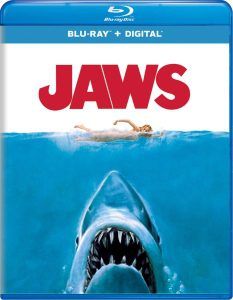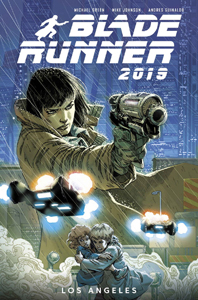The “Blade Runner” franchise continued in novels and a sequel film before finally getting its first comics continuation (not counting “Do Androids Dream of Electric Sheep?: Dust to Dust”) in 2019 – the year of the film’s events. If there was any question of whether “BR” translates to this medium, the answer is a definitive yes.
A wider world
In “Blade Runner 2019” Issues 1-4 (“Volume 1: Los Angeles”), the work by Andres Guinaldo (art) and Marco Lesko (colors) captures the film’s Syd Mead-designed L.A. – the neons and the rains and the noodle kiosks.
It also lets us see the wider world, namely a haven in Baja California for escaped replicants.

“Blade Runner 2019” Issues 1-4 (2019)
Subtitle: “Volume 1: Los Angeles”
Writers: Michael Green and Mike Johnson
Art: Andres Guinaldo
Colors: Marco Lesko
We get a peek into the politics, as our protagonists cross a border manned by cartel agents. Mexico is known as “the narcostates.” Writers Michael Green (“Blade Runner 2049”) and Mike Johnson smartly show the thin, trivial line between legal and illegal officialdom.
This volume builds its world as well as “2049,” but it explains it better. Style and story are in perfect balance here, whereas the sequel film leans heavily into style.
2 storylines
In “Los Angeles,” we follow two storylines. Blade runner Ash – presumably operating parallel with Rick Deckard (he’s never mentioned) – is assigned to track down a presumably kidnapped mother, Isobel, and daughter, Cleo. While this isn’t a hunting job, the LAPD thinks her skills will translate to this assignment.
Ash is of Indian heritage and her boss is a black woman, and this diversity – while the world might not have been ready for it in 1982 – jibes with the world of “Blade Runner.” This dystopian world is also a post-racism world, with racism having shifted into bigotry against replicants.
Perhaps humanity is wired so some group of “others” must always be reserved as a target.
Intriguingly, both Ash and her targets are portrayed as good guys. In Philip K. Dick’s novel and especially in “Blade Runner,” Deckard feels a little odd about hunting replicants, because they so closely resemble people.
That notion is foregrounded in “Los Angeles” because we know Isobel and Cleo as completely sympathetic people.
Sympathetic synthetics (Spoilers)
(SPOILERS FOLLOW.)
And synthetic, in the case of Isobel, who is the replicant wife of Selwyn’s deceased wife. But she has all the same memories as the original Isobel, and Cleo is her daughter in an emotional sense.
Before “2049” confirmed Deckard is a human, fans and even the original film’s creators enjoyed debating whether he might be a replicant. But honestly, this notion was not brought to the fore in Dick’s novel nor the film.

But Green and Johnson dive into the wiggy nature of Ash’s profession when they reveal she has a robotic spine. It needs to be recharged regularly in order for her to walk. So Ash’s job hunting artificial beings pays for her artificial spine. The irony is delicious.
The writers expand the scope further with a network of former Tyrell employees who run an underground railroad for escaped replicants. Deckard and Ash might bury their feelings about making money off hunting, but it’s nice to know that not everyone can be so callous.
Volume 2 promises to expand the world further with Ash and Cleo venturing to the outer colonies. This is also explored in K.W. Jeter’s “Blade Runner 4: Eye and Talon,” but that novel is nearly impossible to find for an affordable price.
So for many readers, Volume 2 marks our first taste of the proper “BR” universe outside the solar system. If it’s anything like Volume 1, it’ll be worth the long wait.

